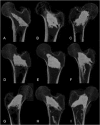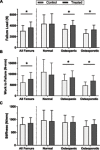In vitro injection of osteoporotic cadaveric femurs with a triphasic calcium-based implant confers immediate biomechanical integrity
- PMID: 30793358
- PMCID: PMC6593990
- DOI: 10.1002/jor.24239
In vitro injection of osteoporotic cadaveric femurs with a triphasic calcium-based implant confers immediate biomechanical integrity
Erratum in
-
Correction to "In vitro injection of osteoporotic cadaveric femurs with a triphasic calcium-based implant confers immediate biomechanical integrity".J Orthop Res. 2024 Jan;42(1):230. doi: 10.1002/jor.25660. Epub 2023 Jul 27. J Orthop Res. 2024. PMID: 37501350 Free PMC article. No abstract available.
Abstract
Current pharmaceutical therapies can reduce hip fractures by up to 50%, but compliance to treatment is low and therapies take up to 18 months to reduce risk. Thus, alternative or complementary approaches to reduce the risk of hip fracture are needed. The AGN1 local osteo-enhancement procedure (LOEP) is one such alternative approach, as it is designed to locally replace bone lost due to osteoporosis and provide immediate biomechanical benefit. This in vitro study evaluated the initial biomechanical impact of this treatment on human cadaveric femurs. We obtained 45 pairs of cadaveric femurs from women aged 77.8 ± 8.8 years. One femur of each pair was treated, while the contralateral femur served as an untreated control. Treatment included debridement, irrigation/suction, and injection of a triphasic calcium-based implant (AGN1). Mechanical testing of the femora was performed in a sideways fall configuration 24 h after treatment. Of the 45 pairs, 4 had normal, 16 osteopenic, and 25 osteoporotic BMD T-scores. Altogether, treatment increased failure load on average by 20.5% (p < 0.0001). In the subset of osteoporotic femurs, treatment increased failure load by 26% and work to failure by 45% (p < 0.01 for both). Treatment did not significantly affect stiffness in any group. These findings provide evidence that local delivery of the triphasic calcium-based implant in the proximal femur is technically feasible and provides immediate biomechanical benefit. Our results provide strong rationale for additional studies investigating the utility of this approach for reducing the risk of hip fracture. © 2019 The Authors. Journal of Orthopaedic Research® Published by Wiley Periodicals, Inc. on behalf of Orthopaedic Research Society.
Keywords: bone aging; bone mechanics and finite element analysis; bone tissue engineering and repair.
© 2019 The Authors. Journal of Orthopaedic Research® Published by Wiley Periodicals, Inc. on behalf of Orthopaedic Research Society.
Figures





Similar articles
-
Treatment of bone loss in proximal femurs of postmenopausal osteoporotic women with AGN1 local osteo-enhancement procedure (LOEP) increases hip bone mineral density and hip strength: a long-term prospective cohort study.Osteoporos Int. 2020 May;31(5):921-929. doi: 10.1007/s00198-019-05230-0. Epub 2019 Dec 4. Osteoporos Int. 2020. PMID: 31802158 Free PMC article.
-
Proximal femoral nailing for intertrochanteric fracture combined with contralateral femoral neck local osteo-enhancement procedure (LOEP) for severe osteoporotic bone loss: An original Italian case series.Injury. 2024 Sep;55 Suppl 4:111408. doi: 10.1016/j.injury.2024.111408. Injury. 2024. PMID: 39542574
-
AGN1 implant material to treat bone loss: Resorbable implant forms normal bone with and without alendronate in a canine critical size humeral defect model.Bone. 2022 Jan;154:116246. doi: 10.1016/j.bone.2021.116246. Epub 2021 Oct 28. Bone. 2022. PMID: 34744020
-
Local osteo-enhancement of osteoporotic vertebra with a triphasic bone implant material increases strength-a biomechanical study.Arch Orthop Trauma Surg. 2020 Oct;140(10):1395-1401. doi: 10.1007/s00402-020-03382-x. Epub 2020 Feb 27. Arch Orthop Trauma Surg. 2020. PMID: 32108254 Free PMC article.
-
Treatment strategies for proximal femur fractures in osteoporotic patients.Osteoporos Int. 2005 Mar;16 Suppl 2:S93-S102. doi: 10.1007/s00198-004-1746-7. Epub 2004 Oct 16. Osteoporos Int. 2005. PMID: 15502962 Review.
Cited by
-
Is Regional Bone Mineral Density the Differentiating Factor Between Femoral Neck and Femoral Trochanteric Fractures?Cureus. 2024 Jan 26;16(1):e53003. doi: 10.7759/cureus.53003. eCollection 2024 Jan. Cureus. 2024. PMID: 38406115 Free PMC article.
-
Treatment of bone loss in proximal femurs of postmenopausal osteoporotic women with AGN1 local osteo-enhancement procedure (LOEP) increases hip bone mineral density and hip strength: a long-term prospective cohort study.Osteoporos Int. 2020 May;31(5):921-929. doi: 10.1007/s00198-019-05230-0. Epub 2019 Dec 4. Osteoporos Int. 2020. PMID: 31802158 Free PMC article.
-
Osteoporosis in 10 years time: a glimpse into the future of osteoporosis.Ther Adv Musculoskelet Dis. 2022 Mar 20;14:1759720X221083541. doi: 10.1177/1759720X221083541. eCollection 2022. Ther Adv Musculoskelet Dis. 2022. PMID: 35342458 Free PMC article.
-
The efficacy of femoral augmentation for hip fracture prevention using ceramic-based cements: A preliminary experimentally-driven finite element investigation.Front Bioeng Biotechnol. 2023 Jan 26;11:1079644. doi: 10.3389/fbioe.2023.1079644. eCollection 2023. Front Bioeng Biotechnol. 2023. PMID: 36777252 Free PMC article.
-
A biomechanically-guided planning and execution paradigm for osteoporotic hip augmentation: Experimental evaluation of the biomechanics and temperature-rise.Clin Biomech (Bristol). 2021 Jul;87:105392. doi: 10.1016/j.clinbiomech.2021.105392. Epub 2021 May 29. Clin Biomech (Bristol). 2021. PMID: 34174676 Free PMC article.
References
-
- Kanis JA. 2007. Assessment of osteoporosis at the primary health‐care level. Technical Report. World Health Organization Collaborating Centre for Metabolic Bone Diseases. UK: University of Sheffield.
-
- Burge R, Dawson‐Hughes B, Solomon DH, et al. 2007. Incidence and economic burden of osteoporosis‐Related fractures in the United States, 2005–2025. J Bone Miner Res 22:465–475. - PubMed
-
- Johnell O, Kanis JA. 2006. An estimate of the worldwide prevalence and disability associated with osteoporotic fractures. Osteoporos Int 17:1726–1733. - PubMed
-
- Gullberg B, Johnell O, Kanis JA. 1997. World‐wide projections of hip fracture. Osteoporos Int 7:407–413. - PubMed
-
- U.S. Congress Office of Technology Assesment. 1994. Hip fracture outcomes in people age 50 and over‐background paper, OTA‐BP‐H‐ 120. Washington, DC: U.S. Government Printing Office.
Publication types
MeSH terms
Substances
LinkOut - more resources
Full Text Sources
Medical

